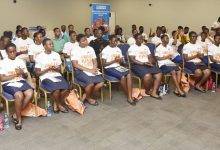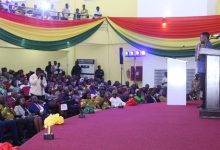Drs. Josephine Larbi-Apau and Benjamin Kwofie
May 6, 2020
The coronavirus, Covid-19 pandemic has pushed the government through the Ministry of Education to close all schools in Ghana. With comparative rigidly structured nature of our educational system, many institutions are wrestling with uncertainties regarding tuition revenue, admissions, continuity, models of student engagement, course delivery systems, and assessment techniques.
The most affected are the private tertiary institutions and financially weaker ones. Without the students, revenues will predictably fall, and institutions may find it difficult to meet their financial obligations regarding administration and payment of remunerations to employees including teachers, faculty and administrative staff. The public schools are not immune either since their subventions may be channeled to fight the spread of the virus. Both publicly and privately owned institutions are challenged by unpreparedness to use ICT as a mediator for pedagogy, inadequateknowledge in online learning management, and types of eLearning solutions to deploy. Digital course contents design, digital divide resulting from unequal access to technology and the Internet, and limited ICT infrastructure may pose serious challenges.
Unfortunately, the existing regulations on education in Ghana also do not reflect how technology or ICT should be integrated for e-pedagogy, eLearning and e-assessment. The focus has been on learning about ICT rather than educational technology. Yet, some forward-looking and innovative institutions have been experimenting on the use of ICT-mediated teaching in the “quiet” as they do not want to be seen as violating existing regulations and provisions. With limited training and inadequate resources, a total shift from a system of education that has focused on physical interactions for decades in Ghana, to distance and online learning systems within the shortest period in history would be described as unprecedented.
The pandemic has compelled many educational leaders to grapple with eLearning transitions, and the question is, how will they cope?Granted the lockdown and closures of the schools continue for a longer period, our traditional methods of course and learning delivery will fail us, if we do not learn to buildbetter and innovative learningand instructional models.
The Hard Truth
A documentary featured on innovative education globally was aired on a foreign television about a month ago. With emphasis on online learning and technology as key mediating factors, it was inferred that it will take 100 years for developing countries to reach where developed countries are today.
Unlike a developing country like Ghana, many educational institutions in developed countries have moved their classes online, suggesting continuity and a measure to address the effect of the coronavirus pandemic. With ease, these institutions aredeploying classes online, orienting teachers and students, and developing course materials in a matter of days because they have been implementing such practices alongside the physical residential systems for years. The State of Florida in the USA as a typical example, has been implementing a public, nonprofit virtual kindergarten to high school (K-12) system for over two decades to address the online learning needs of the students. Such a school can transition smoothly to online learning in the heat of a corona virus pandemic. In fact, available reports suggest that before the outbreak, the Florida Virtual High School (FLVS) had enrolled 200,000 students, primarily in-state, across all 50 states in the USA and overseas. It is predicted that the FLVS will double direct enrollment by the end of April and train at least 10,000 Florida teachers to migrate their own classes online, and this can be achieved through online training and pre-recorded webinars.
Before the pandemic, the World Education Services (WES) report showed that Ghana’s education system was ingood condition compared with those of many other sub-Saharan African nations, except that it was faced with enormous challenges in providing inclusive, high-quality education to its youth as a result of its rapid population growth. Without a doubt, there has been an exponential growth in the student enrolments; thanks to the free senior high school policy in 2017. Until this policy, almost 100,000 students reportedly, did not transition to secondary or senior high because of financial constraints. Enrolment was relatively low.
SchoolEnrolment: Available statistics for the 2017/2018 academic year indicate that the school age population in Ghana at all levels is about 13 million. The total at preprimary is 1.55 million, primary is 4.33 million, secondary is 4.41 million, and tertiary is 2.83 million. Ghana has about 64,000 public and private basic schools, and with almost 10 million students at the pre-tertiary levels, the total number of teachers that handles this group of students is about 72,000. Literally and all things being equal, the teacher to student ratio (TSR) at that level is 1:139.
The National Accreditation Board (NAB) reports a total of 191 accredited tertiary education institutions, made up of 94 public and 97 private ones in Ghana. Tertiary institutions cover traditional and technical universities, polytechnics, distance learning institutions, nursing training colleges, colleges of education, professional and chartered private institutions, among others. The World Education Services (WES) data for the 2017/2018 academic yearput enrolment in public universities at 244,079. Per the UNESCO UIS data, the total number of all tertiary students increased substantially from about 16,000 in 1980 to 444,000 in 2017. Out of this total, the University of Ghana has a population of about 38,000 students, KNUST has about 42,000 students and University of Cape Coast has almost 75,000 students. All the three universities offer post-graduate, undergraduate, sub-graduate degrees, and diplomas.
As part of the strategies to curb the Covid-19 crisis on education, the Education Minister, Hon. Dr. Mathew Opoku Prempeh announced that in collaboration with the Open University-UK, Ghanaian students could use the OU’s OpenLearn educational resources. The President, His Excellency Nana Akuffo-Addo also proposed distance education to address the learning needs of students. In view of these developments, can we say the Covid-19 outbreak has presented an exigent opportunity to innovate the Ghanaian schools and educational system in general?
Given the student enrolments andannouncements, we do believe the institutions have received clearer directions for the way forward. Notably, some institutions and associations are partnering with certain local television stations to resume the earlier era of distance learning, where teaching and educational resources are made available through television broadcast. These are paraded as “eLearning”. Yet a critical review shows that many of the presentations are still teacher-centered, the quality of the instructional materials is incredibly low, and the potential of achieving the intended purposes is negligible. In fact, mimicking the general trends of global education in the past, the broadcast of educational materials and teaching viaradio and television was practiced in the early 1960s and late 1990s in Ghana, respectively. Through radio, subjects like English and Mathematics were offered during defined classroom hours as part of the teaching time tables. Teachers then engaged the students and followed up the lessons with discussions for clarity and meaning of the materials learned. Are students without televisions and access to certain channels not excluded? Who discusses the materials after the broadcast? What is the way forward?
Ghana is recognized by the World Bank as one of the top spenders in education in Africa, yet the report also suggested that a chunk of the spending goes for recurrent expenditure such as payments in wages and salaries rather than in infrastructure, teaching, learning aids and major reforms in tertiary education (WES data). Shutting down schools with minimal options and limited resources is very disheartening, but these are the hard truths.
Curbing the Effect of COVID-19:Now and Beyond
The general health and socio-economic effects of the Covid-19are dependent on international and domestic directives, but the effect on education is dependent largely on individual states and countries. Ghana needs to adopt innovative approaches to curb the pandemic now and beyond. Suchapproaches must include eLearning, online, mobile and distance learning, open education, online assessment, continuous professional development of teachersandfaculty, and students’ orientations. We have to address inequalities, develop e-Libraries, and integrate policies to encourage ICT-mediated learning. These requirements are briefly explained as follows:
eLearning: eLearning involves the use of electronic applications and processes to learn. It emphasizes individualized instruction delivered over Internet or Intranet computer networks. All categories of learners or student can be engaged via eLearning, however research shows that younger learners or students do not have longer span of attention to learn online for long hours on their own; hence short or segmented lessons using videos, group meetings, and self-paced learning are advised. In the long term, a hybrid or blended learning and flipped classroom among others may be more suited foryounger students, comprising basic and high schools. In contrast, adult learners, especially in tertiary institutions are more accommodating and have longer attention span.
In bothcases, virtual office hours, phone calls, emails, SMS texts, social media and other means of communication can be integrated in class to get students engaged meaningfully. Using social media can become handy and appropriate in the virtual classroom. Tertiary education students can connect with other students for the learning experience. Face-to-face groups can be transformed into virtual groups and can be achieved by either integrating purposely selected social media or by using the group forming features that come with most learning management systems. In addition, institutions can encourage students to create user-friendly apps that can connect them with the services and information they need on their various campuses. After all, students while at home, are connecting with each other and their communities by sharing information about the Covid-19 pandemic and other engagements through social media such as WhatsApp.
OnlineLearning: Online learning is digitally delivered learning and is associated with flexibility in course delivery, management, assessment and grading systems via the Internet. Online learning is usually delivered through a learning management system (LMS) software. Deploying a learning management system requires an expansive ecosystem of feasibility studies, evaluation and selection of the software, installation, training of users, development of digital and interactive course contents, course migration, and many more. It is critical for institutions to engage qualified instructional designers and technologies to transform “static” course and subject materials into dynamic and interactive formats. Teaching faculty has to learn how to “teach” or facilitate online learning which is more student-centered than lecturer- or teacher-centered.
Interestingly, within the shortest period of the announcement of school closures, some institutions have already migrated online and are reopening. The concern is these institutions could not have had the luxury of time to consider what to look for in a new learning management since all of them are not the same. While many LMSs can support blended and online learning at a glance or through recommendations, there are myriads of differences that can be critical in supporting specific institutional needs and goals. The most advisable thing to do is to study the feasibility and evaluate types of LMS software for best fit. Social media are not the definitive.
Again, as the effect of the Covid-19 seems to push these considerations, the technical institutions will have to employ creative ways to offer competency-based education and hands-on-learning online. They need more time to factor flexibility, types of interactions, skill development and credit hour requirements into the online practices. Teacher-developed digital instructions could be supplemented with open educational resources (OERs) to provide a plethora of teaching and learning resources such as videos, simulations, case studies, and demonstrations to help students to make meaning of materials learned in class. Such resources are available for all levels of students.
Practitioners should note that while eLearning comprises learning through various electronic media; online learning deals with learning delivered through the Internet or the Web. Regular courses may have minor issues with digital design and delivery of contents, however competency-based institutions such as the technical universities have to position requirements in context.
MobileLearning: Many Ghanaians are spending more time on their phones than ever before. Others are noted to hold multiple phones and engage with social media platforms for most of the time. Time and again, teachers have debated on whether to allow mobile phones in their classes. The answer is why not? In fact, this article is limited in scope to address the capabilities of mobile technologies and devices as course delivery tools, but teachers and lectures have to be reminded that they are the managers of their classes. They should note that mobile learning involves any educational interaction delivered through mobile technology and accessed at a student’s convenience from any location. Devices for accessing mobile learning include phones, tablets, iPods, iPads, other hand-held and wearable devices, and netbooks (ELI 2003).
DistanceEducation: Distance education defines a learning delivery method where the teacher and students are separated in time and geographical space.Distance education is placed by Moore and Kearsley in 2005 as a valued factor of many educational systems that has proven its worth in areas where traditional schools, colleges and universities have had difficulties such as meeting demands of large systems that are capable of handling hundreds of thousands of students or more. It can be valuable in these challenging times.
Brilliantly articulated by Taylor in 2014, distance education has evolved from the print and correspondence model of the 1700s to computer-based and-assisted learning, telelearning such as webinars and teleconferencing, as well as web-based learning management systems, to multiple intelligence models where access to digital multimedia is helping to create intellectual single entities. The question is, where is Ghana in these generational models since institutions that offer distance education continue to commute to learning and study centers for physical interactions with their distance students? Just take a trip to Accra in the early hours of Saturdays to count the number of institutional vehicles on the road to “distance” learning centers. What has become of these students without the physical presence of their instructors and tutors?With the advent of technology and the Internet, many distance education courses and programs can be offered online.
OpenEducation: Open education or learning is another model of educational system where course and educational resources are provided free of charge to potential learners anywhere in the world without having to register as students. For instance, an open university offers higher or tertiary education to all regardless of learners’ circumstances or location. Enrolment is diverse and open to learners without boundaries. Such institutions can offer open admissions, educational resources, curricula, pedagogy or teaching, publication,equal access, standards, technology and flexible learning policies, interalia, and can ensue through distance and online programs.
Enrollment is all year-round and learners can complete courses at any time and graduate at will. However, openness in open education and in distance learning is eclectic and associated with labels of all kinds; hence institutions that want to tread this path in Ghana must define their models in context for clarity, authorization and standards. For instance, are these open models based on open admission? Open pedagogical practices? Open educational resources? Open access? Flexibility and equality policies? Structured? Unstructured? Or in mixes?
Assessment: Assessment through technology, online and distance educationis quite different from that of face-to-face or physical engagements. In such contexts, assignments can be designed to be completed on students’ own time, but within the structured semester models in Ghana. Teachers and lecturers of the various subjects and courses can organize live lessons through videos and virtual classroom chats. In these cases, instructors and students can communicate for the purposes of assessments. Live video conversations can provide the means to check for mastery of learning. Project and discussion-based assessments are reliable and can be graded effectively. Online proctored services are also available for conducting examinations, and most learning management systems can support independent and individualized examinations without the fear of academic malpractices. In fact, many of the digitized systems are proven and more reliable than physical systems.
AddressingInequalities: Not limited to higher or tertiary educational institutions, certain basic and high schools in Ghana lack Internet connectivity, Internet is slow, or both. The issue of inequality is complicated by the fact that, WIFI and hotspots which may be readily available on many campuses are unavailable in most rural communities; thus students in these communities are by default disconnected from the reality. Notwithstanding, the high cost of data plans is prohibitive for the average Ghanaian family and for educational purposes where longer hours of use may be required as compared with personal or non-educational use. Again, not all students have accesses to laptops or smart mobile devices. While some students share technology and Internet resources with family members, the younger students or pupils use parents’ phones and devices to reach out to other students. The least said about gender disparity, the better.
A recent engagement with UbuntuNETAlliance in Madagascar revealed that the NRENs – National Research and Education Networks, and for that matter WACREN – West and Central Africa Research and Education Network can collaborate with governments and relevant stakeholders to strengthen campus network infrastructure for better digital and innovative teaching and research. Through WACREN, educational institutions can negotiate with the telecommunication industry, particularly the Internet service providers (ISPs) for increased high-speed Internet and discounted rates to support virtual education. As the government seeks to address the inequalities through national policies, the least parents can do is to provide access to eLearning devices and monitor their use by youngerstudents at home.
e–Libraries: Institutions must not be cutting sods for the construction of e-Libraries as is the case in Ghana. An e-Library is an online or electronic-based system that supports cataloging and indexing of online resources including software programs and digital contents like books, articles, journals and novels that can be accessed via the NET at the comfort of the users’ home.
PoliciesandRegulations: Relevant policies are required to direct innovative practices such as online learning, adaptive and micro learning, and open education practices (OEP). The current tertiary education policy of 2018 does not address the requirements for innovative teaching in a contemporary and global ICT-mediated education adequately. The policy on Collaborative Positioning and Flexible and Distributed Learning (Article 3.2.4) in tertiary education is limited in scope and technically lacks clarity of purpose. As a short-term measure, the government through the education ministry can issue distance and online learning rules which will include flexibility,open education,and competency-based education via the Internet and other electronic platforms. However, in the medium to long term, a team of subject matter experts can be put together to develop relevant educational technology policies for all school levels. The difference between educational technology (EdTech) and information and communication technology (ICT) is clear. These disciplines are not the same; they complement each other in the delivery and management ofdistance, online learning or eLearning effectively.
Conclusion
Evidently, the government, education ministry and institutions are under unprecedented pressure to curb the effects of Covid-19 on education. Coming up immediately with regulations on the use of non-traditional programs will encourage institutions to launch more of online or distance learning programs with assurance and confidence. We must not understate a robust national oversight responsibility, authorization and accreditation to ensure quality, standards and smooth transitions. For long term educational use, the Internet connectivity gap will have to be closed reasonably. It is important for institutions to make these transitions a school, university or tertiary education project that involves all stakeholders. They will have to embark on major regulatory overhauls that aim at quality instructional designs and curriculum reforms for student-centered and self-directed learning. Students at all levels will need general orientation to transition smoothly.
As Ghanaians, we have to understand that there is no such thing as perfect in the distribution of “common goods”. No matter how governments try to reach out to rural communities, access to the Internet and other ICT infrastructure would take time. We are the government, and as we struggle through this tunnel of darkness, we must take comfort from the factthat there is always light at the end of the tunnel. The changes we make in our educational institutions today must stick after the Covid-19 pandemic dust settles.Goonline, stay at home and be safe.







